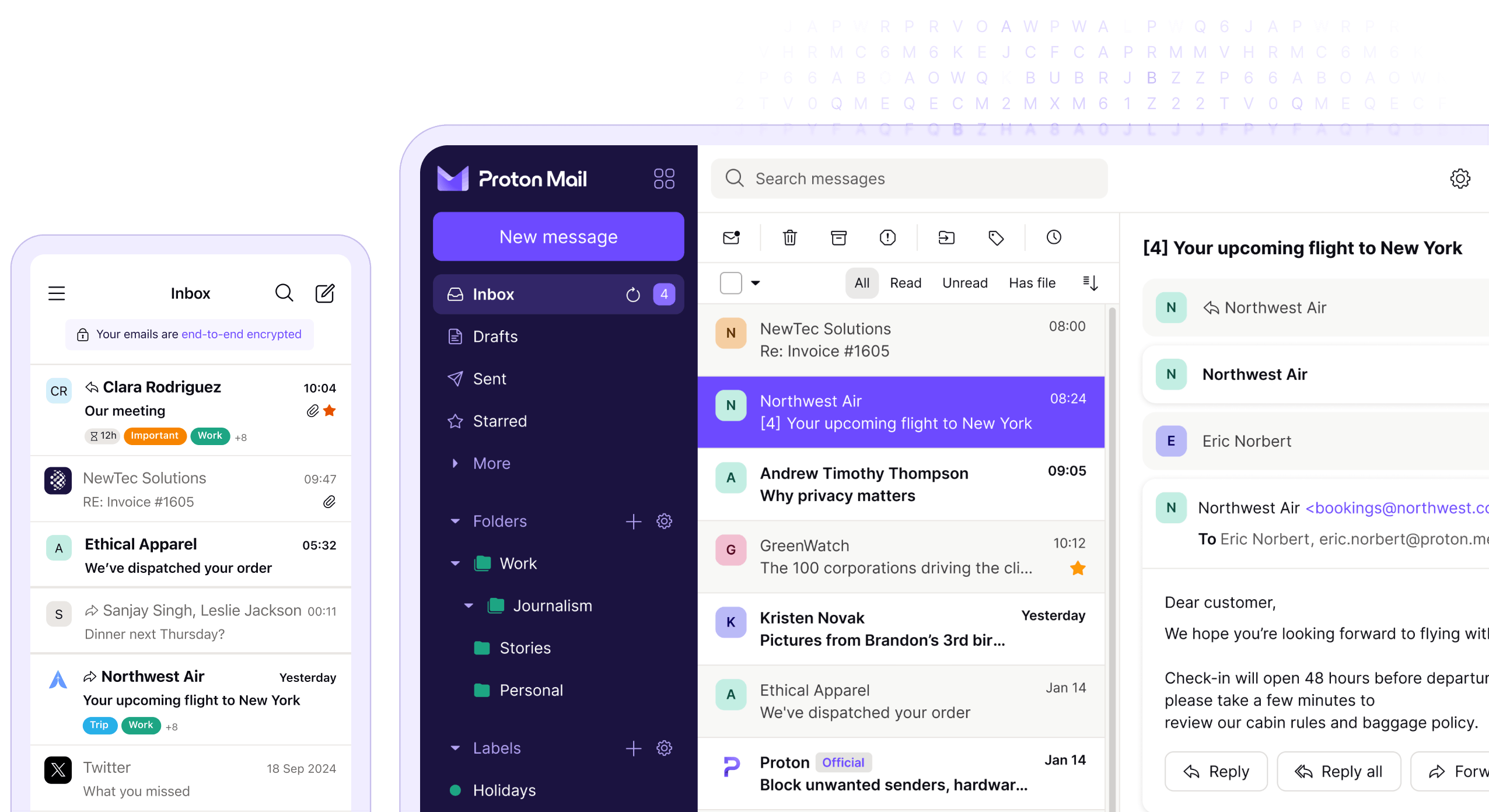Wsparcie dla Proton Mail
Znajdź odpowiedzi na swoje pytania dotyczące Proton Mail. W czym możemy Ci pomóc?

Kategorie Proton Mail
Pomożemy Ci na każdym etapie korzystania z Proton Mail, od założenia konta po wysłanie Twojego pierwszego maila.
Najczęściej zadawane pytania
Bezpieczeństwo użytkowników to nasz priorytet. Oto nasz sposób na zabezpieczenie Proton Mail:
- Szyfrowanie end-to-end: Wiadomości między użytkownikami Proton Mail są przesyłane i przechowywane na naszych bezpiecznych serwerach w zaszyfrowanym formacie. Ponieważ Twoje dane są szyfrowane na wszystkich etapach, ryzyko przechwycenia wiadomości jest w dużej mierze wyeliminowane.
- Brak dostępu do Twoich danych: tylko Ty masz klucz do odszyfrowania swoich wiadomości i plików przechowywanych na naszych bezpiecznych serwerach. Twoje dane są niedostępne dla innych osób, również dla nas. Nie posiadamy klucza dostępu do Twoich danych, więc nie możemy przekazać ich stronom trzecim.
- Wiadomości e-mail chronione hasłem: Wiadomości między użytkownikami Proton Mail są automatycznie szyfrowane end-to-end. Możesz też wysyłać zaszyfrowane end-to-end wiadomości do osób korzystających z innych dostawców poczty e-mail, korzystając z wiadomości e-mail chronionych hasłem lub standardowego szyfrowania PGP.
- Otwarty kod źródłowy: Wszystkie nasze aplikacje mają otwarty kod źródłowy i są niezależnie audytowane, więc każdy może sprawdzić nasz kod.
- Bezpieczeństwo fizyczne: zainwestowaliśmy wiele w posiadanie i kontrolowanie własnego sprzętu serwerowego. Nasze centra danych znajdują się w wyjątkowo bezpiecznych miejscach, które wymagają dostępu biometrycznego.
Stworzyliśmy Proton Mail, aby zaszyfrowane wiadomości e-mail były łatwo dostępne dla każdego. Wiemy, że niektórzy ludzie potrzebujący naszych usług nie są w stanie za nie zapłacić. Dlatego oferujemy Proton Mail Free, naszą bezpłatną skrzynkę e-mail, która zapewnia ten sam poziom bezpieczeństwa i łatwości użytkowania, co w przypadku płatnych planów.
Jeśli chcesz mieć więcej przestrzeni dyskowej, nieograniczone foldery, etykiety, niestandardowe filtry, domeny e-mail i nie tylko, rozważ ulepszenie do planu płatnego. Nie tylko uzyskasz dostęp do zaawansowanych funkcji, ale wesprzesz również nasze działania, aby uczynić sieciową prywatność i bezpieczeństwo dostępnymi dla każdego.
Szyfrowanie polega na konwertowaniu wiadomości i informacji w taki sposób, aby tylko upoważnione strony mogły je odczytać. Wiadomość jest przekształcana w nieczytelny ciąg znaków przy użyciu złożonych algorytmów. Jedynym sposobem na przywrócenie jej pierwotnej formy jest użycie unikatowego klucza szyfrującego.
Gdy wysyłasz wiadomość e-mail do innego użytkownika Proton lub odbierasz od niego wiadomość, treść wiadomości i załączniki są automatycznie szyfrowane na każdym kroku. Nazywa się to szyftowaniem end-to-end.
Wszystkie wiadomości i załączniki odbierane w skrzynkach Proton Mail są przechowywane z użyciem szyfrowania po stronie klienta, w tym także wiadomości od innych dostawców poczty e-mail. Tylko Ty masz klucz dostępowy do wiadomości i plików na naszych bezpiecznych serwerach. Oznacza to, że Twoje dane są niedostępne dla innych osób, również dla nas.
Możesz także wysyłać wiadomości z szyfrowaniem end-to-end do osób korzystających z usług innych dostawców, używając e-maili chronionych hasłem.
W przeciwnym razie będą chronione szyfrowaniem TLS, jeśli obsługuje je serwer inny niż Proton Mail.
Proton ma cztery różne domeny e-mail, których możesz używać do tworzenia adresów e-mail:
- @proton.me to domyślna domena dla Proton Mail. Kiedy się zarejestrujesz, pojawi się prośba o utworzenie adresu @proton.me (twojanazwaużytkownika@proton.me).
- @protonmail.com to alternatywna domena, którą możesz wybrać podczas rejestracji lub użyć do tworzenia dodatkowych adresów (twojanazwaużytkownika@protonmail.com).
- @pm.me to nasza krótka domena. Możesz aktywować swój krótki adres e-mail (twojanazwaużytkownika@pm.me) po zarejestrowaniu się, jeśli Twoja nazwa użytkownika jest dostępna.
- @protonmail.ch to nasza oryginalna domena Proton Mail. W przypadku dołączenia do Proton przed rokiem 2016 otrzymujesz dodatkowy darmowy adres @protonmail.ch (twojanazwaużytkownika@protonmail.ch).
Aby aktywować adres @protonmail.me, zaloguj się na swoje konto (account.proton.me) i kliknij Ustawienia→ Przejdź do ustawień → Tożsamość i adresy.
Jeśli masz płatny plan Proton, możesz utworzyć dodatkowe adresy (aliasy), używając dowolnej domeny Proton lub swojej własnej domeny niestandardowej (@yourdomain.com).
Dowiedz się więcej o rodzajach adresów i aliasach
Możesz również ustawić dowolny adres jako domyślny adres nadawczy.
Proton Mail Bridge to aplikacja dla systemów Windows, macOS i Linux. Umożliwia korzystanie z konta Proton Mail z zewnętrznymi klientami poczty, takimi jak Outlook, Thunderbird i Apple Mail, zachowując przy tym bezpieczeństwo e-maili dzięki szyfrowaniu end-to-end Proton Mail.
Proton Mail Bridge jest dostępny dla wszystkich płacących subskrybentów. Aby go używać, zainstaluj aplikację Proton Mail Bridge, a następnie skonfiguruj ulubioną aplikację pocztową.
Jeśli masz płatny plan Proton Mail, możesz używać niestandardowej domeny do wysyłania i odbierania wiadomości (np. używając adresu e-mail yourname@yourdomain.com). Liczba dostępnych niestandardowych domen zależy od Twojego planu Proton Mail.
Możesz kupić domeny niestandardowe od zewnętrznych rejestratorów, np. GoDaddy, Cloudflare lub Namecheap. Aby użyć domeny niestandardowej z kontem Proton Mail:
- 1. Dodaj swoją domenę do konta Proton Mail.
- 2. Zweryfikuj domenę, aby Proton wiedział, że należy do Ciebie
- 3. Skonfiguruj rekordy DNS rejestratora domeny, aby Proton Mail obsługiwał e-maile odbierane i wysyłane za pomocą tej domeny
Dodatkowe kroki są wymagane, jeśli posiadasz plan Proton for Business i chcesz dodać użytkowników ze swojej organizacji, aby mogli używać Twojej niestandardowej domeny.